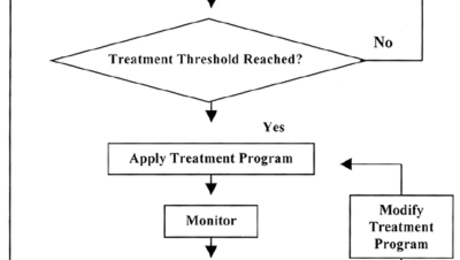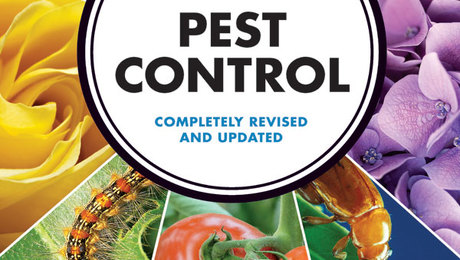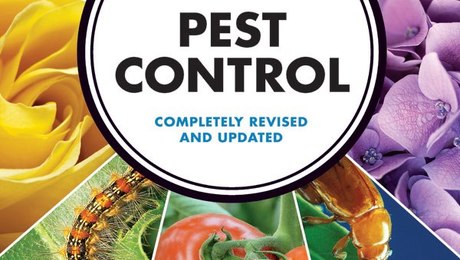If you live on the West or Gulf Coasts of the United States, garden pests may already be starting to arrive (if they ever even left for the winter). In the Midwest and northern tier of states, you are probably looking at the recent snowfall outside, and after shoveling it, with any luck, you are sitting down to read a gardening book (ours we hope) and perusing some seed catalogs. Wherever you live, it’s time to plan a garden that is less inviting to pests.
First, though, you may want to check out a few definitions that will tell you what we’re about. I’ve included some common IPM terms at the end of this blog. I’ll define more terms in subsequent postings; after all, it is a blog, not a glossary . . . well not usually. Of course the GG-CSPC book defines all of the IPM and related terminology with examples from all four authors’ experiences (more about the authors and books at the end of this blog). Our focus here is the garden, but IPM works in any situation, including structures, pets, the community, and people, to mention just a few.
To prepare for a garden that will have fewer pest problems, the first step is planning. The plant species and cultivars you choose and the layout of your garden will have a strong bearing on whether you have pest problems or not. We call this “designing pests out of the garden system” or “designing relaxation into the garden system.” This means selecting a species/cultivar that performs well in your area, the mix of plants you use, and where the plants are laid out with respect to one another and the immediate environment (sun exposure, wind, etc.). Choosing the best plants and their placement helps ensure that you will have more time to enjoy your garden rather than battling pests. The first “IPM key” is the planning.
The most frequently ignored aspect of planning a garden is time. It is your time to garden that I’m talking about. To paraphrase the old adage, “If you don’t have time to do it right the first time, when will you have time to correct it?” For IPM to work in your garden, you will need to invest an appropriate amount of time caring for your garden. If you don’t have much time, consider using perennials that will fit the available space nicely when mature. This reduces pruning time .Consider this, and be honest: When is your busiest week of the gardening season? How many hours do you have to devote to your garden that week? That realistic number of hours provides you with an estimate on which to base your garden design and its needs. Don’t fudge here; insufficient time spent on maintenance is the primary cause of unsuccessful gardens.
IPM: Integrated pest management is a decision-making systems approach to pest control that uses regular monitoring to determine if and when treatments are needed. It employs physical, mechanical, cultural, biological, and educational tactics to keep pest numbers low enough to prevent intolerable damage or annoyance. The least-toxic chemical controls are used as a last resort. In IPM programs, treatments are not made according to predetermined schedules; they are made only when and where monitoring has indicated that the pest will cause unacceptable economic, medical, or aesthetic damage. Treatments are chosen and timed to be most effective and least disruptive to natural pest controls.
Monitoring: This is the action of comparing two or more inspections to determine whether pests are increasing, decreasing, or remaining the same. It helps you determine if beneficial organisms are present. For example, if you want to determine if your car is burning oil, one look at the oil dipstick will tell you very little. Checking it a second time a few days or a week later will let you know if the oil level is the same as the first time or lower. It’s the comparison of the two readings that is the key to determining what’s happening.
Pest: Any organism that is present in a place you do not want it to be. While most people think the word “pest” refers only to insects and other arthropods, it also encompasses weeds, plant diseases, animals, birds, fungi, snails, microbes, and many others. Keep in mind that the term “pest” is subjective; it’s often a personal decision. We quote Hugo Hartnack in the book: “No animal is a pest. The way each of us feels about a visitor determines whether the animal is welcome or not, whether it is a pet or a pest, or, in the old Latin words, hospes or hostis, a guest or a foe.” Of course, this is true of all organisms, not just animals. An award-winning rose in a cornfield would be considered a weed.
Treatment action: In IPM, a treatment action is anything you do that favors the desired plants and discourages the pest. Hand-pulling weeds, pruning out diseased plant parts, releasing or attracting beneficials, installing barriers to pests, trapping and removing snails/slugs, and using compost and mulches are some examples of treatment actions. In IPM, treatment actions almost always mean something other than using a pesticide. In what seems like an oxymoron, sometimes the treatment action of choice is to do nothing and let nature take its course. It’s the home garden version of “survival of the fittest.”
Next week: I’ll talk a little more about planning aspects, including sustainable gardening and landscaping, and what kind of garden it is that you want. Remember, we are “designing pests out of the garden system” and “designing relaxation time into it.”
IPM and the Gardener’s Guide to Common-Sense Pest Control (GG-CSPC)
This series of blog posts is the companion to our book The Gardener’s Guide to Common-Sense Pest Control (or GG-CSPC as we call it), published by Taunton Press. This is the newly revised and updated edition of the 1995 original Gardener’s Guide, which was drawn from the classic big book Common-Sense Pest Control, published in 1991. Practitioners of IPM (integrated pest management) often refer to these two books as the “integrated pest management Bibles.” For over 20 years I’ve used these books as my primary IPM resource in the field, in my consulting practice, and in my home garden.
The authors of the original GG-CSPC are William Olkowski, Sheila Daar, and Helga Olkowski. The co-author and editor of the revised and updated edition is Steven Ash (that’s me). One quick note on the blog’s “voice”: When I speak of something in the book, I’ll use “we,” which means one or more of the four authors was involved in some way. In the blog itself, I’ll use “I,” since it’s me talking to you. Just so you don’t think I have multiple personalities when I use “we.”
See all the Common-Sense Pest Control materials here.

















Comments
Very helpful blog. We rarely take planning into consideration. Just go to the store, buy the seeds and plant them. Then wait to see what comes up. I don't need to tell you how many times we have been disappointed with the results of our efforts. But the disappointment always comes two months latter.
Keep writing these helpful hints and remember most of us need things presented in as simple a way as possible.
Oakley Sunglasses sale ,Oakley sunglasses, fashion or function with the glasses popular and the majority trusted brands, Oakley's new product may be released as a preview, delete Frogskin, a narrow product. OAKLEY Holbrooke hire an inclination to cup dual function. The primary correct features and factors. ray ban outlet ,Oakley Sunglasses lenses are safe, no pressure, may customize the optical pause, and that means you have to be truthful and accurate vision of premium clarity. Oakley sunglasses in many cases are the dedicated efforts and expensive high-tech results of the survey. Sunglasses in the past number of years has increasingly become a real fashion designers than in the past. OAkley dispAtch ,Try looking in cheap designer sunglasses, they seem to acquire this amazing situation. All of them to help keep throughout the advance of their own eyes.
The look inspiration for Oakley, Oakley LIVESTRONG exclusive edition sunglasses from U.S. Mlb official glasses that may help you make that person more mysterious. Comfortable being a set of two modest sunglasses sunglasses several dark lens held by way of a framework, in order to maintain in the Gulf harmful rays, which is ugh as a consequence. Oakley sunglasses are fashionable for females to wear in the summertime, beautiful, if you are driving a vehicle in the summer, wearing Oakley sunglasses you will definately get a much better visual experience. You end up picking an available selection of sunglasses, these sunglasses are the activities arranged by polarization, the existing style, special and restricted model. Oakley polarized Oakley online to seek the protection needed, there is the perfect couple of sunglasses. A broad selection of frames and lenses they come, and budget.
Art means the packaging these inventions. Oakley sticking with this view, and deeply rooted from the core of our own culture. The brand to provide a polarized, hydrophobic, light-induced discoloration from the lens and RX Sun, in order to ensure the safety of the eye, and even an engaged lifestyle. Furthermore, all Oakley lens has excellent impact protection, 100% with the UV filter and incomparable HDO high-definition. Fortunately, Oakley sunglasses have different prices to satisfy their quality, but less difficult than trawling round shops to purchase online suppliers.
I Will Be Coming Back Soon, Thanks for posting Some Great ideas and I'll try to return back With A Completely different browser to check out Things! Also, I put a link to your blog at my site, hope you do not mind.
This guide is not only going to help a gardener but also to many of the people, who want to have pest removal services.
bee control
This guide is not only going to help a gardener but also to many of the people, who want to have pest removal services.
http://www.azbestpest.com/bee-control-and-removal-services/
Log in or create an account to post a comment.
Sign up Log in